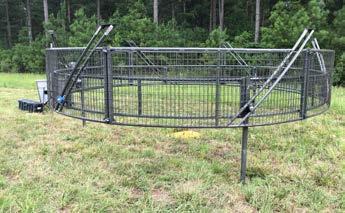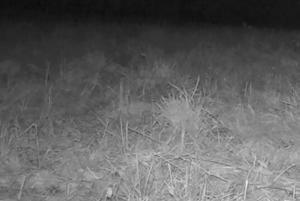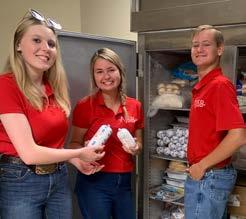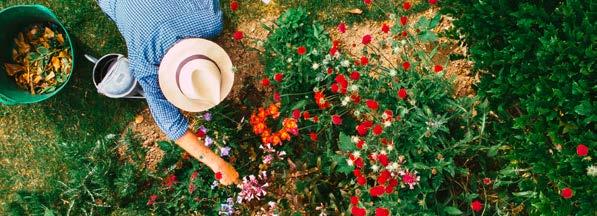Haynes Farms

Competes for Regional Title
It’s Pumpkin Pickin’ Time
Recipes to Celebrate Beef Month

October 2023 | Volume 48 | Number 9
Marlee Jackson | Editor
Laura Unger | Graphic Designer
ALABAMA FARMERS FEDERATION

Paul Pinyan Executive Director
Jeff Helms | Director of Communications
FEDERATION OFFICERS
Jimmy Parnell | President, Stanton
Rex Vaughn | Vice President | North, Huntsville
Jon Hegeman Vice President | Central, Anniston
George Jeffcoat Vice President | Southeast, Gordon
Jake Harper | Vice President | Southwest, Camden
Steve Dunn Secretary-Treasurer, Evergreen
DIRECTORS
Dorman Grace | Jasper
Jeff Peek | Athens
John Bert East Leesburg
Steve Lake | Vinemont
Joe Anders Northport
Phillip Hunter | Birmingham
Joe Lambrecht | Wetumpka
Tommy Martin | Moundville
Bill Cook Montgomery
Trip Horne | Louisville
Mark Kaiser | Daphne
Thomas Adams Newville
Ann Whatley | Opelika

Jonathan Edgar Wetumpka
Neighbors (ISSN 0162-3974) is published monthly by the Alabama Farmers Federation, 2108 East South Boulevard, Montgomery, Alabama 36116 or (334) 288-3900. For information about Alabama Farmers Federation member benefits, visit the website www.alfafarmers.org. Periodicals postage paid at Montgomery, Alabama, and additional mailing offices.

Printed in the U.S.A.
In This Issue
4 | Sweet Potato Cheesecake Takes Top Prize in Contest

8 | Pumpkin Patch Helps Farm Family Build Community

10 | Sumter County Program Curtails Invasive Species
14 | Petite Pleats, Tiny Stitches Yield Smocked Treasures
28 | Celebrate Beef Month in the Farmhouse Kitchen
POSTMASTER
Send address changes to Neighbors
P.O. Box 11000, Montgomery, Alabama 36191-0001
MEMBERSHIP AND SUBSCRIPTION CHANGES
800-392-5705, Option 4 or BWatkins@alfafarmers.org
ADVERTISING REPRESENTATIVE
Ben Shurett, (256) 997-7922 BenShurett.alfafarmers@gmail.com
DISCLAIMERS: Advertisements in Neighbors do not represent an endorsement by the magazine or Alabama Farmers Federation. Editorial information from sources outside the Alabama Farmers Federation is sometimes presented for our members. Such material may, or may not, coincide with official Alabama Farmers Federation policies. Publication of information does not imply an endorsement by the Alabama Farmers Federation.
www.AlfaFarmers.org
18 | Inaugural Jr. Swine Board Centered on Service
17
On The Cover
Darrel Haynes is Alabama’s candidate for the Southeastern Farmer of the Year contest, held annually in Moultrie, Georgia. He and wife Lydia raise row crops, cattle and hay at Haynes Farms in Cullman County.
Photo By Jeff Helms
14
A member of American Farm Bureau Federation
8
October 2023 | NEIGHBORS | 3
4 alfafarmers.org
Cheesecake Recipes Spotlighted at Heritage Cooking Contest

 By Maggie Edwards
By Maggie Edwards
Twenty-three Alabama Farmers Federation members put their baking skills to the test during the cheesecake-themed Heritage Cooking Contest Sept. 7.
“It’s more than cheesecake,” said first-place winner Jeanette Tew of Elmore County. “It’s the support between the ladies — in cheesecake and life. This is a community of women who love each other and work together. It’s a labor of love.”
Tew said preparing for the contest was her first attempt at baking a cheesecake.
“This contest taught me patience and growth,” Tew said. “My process was trying to find something unique.”
Unique indeed.
Her Sweet Potato Pecan Baked Cheesecake sang on the judges’ taste buds with a sweet taste of fall.

“My family loves sweet potatoes,” Tew said. “It was a challenge, because
Sweet Potato Pecan Baked Cheesecake
 By Jeanette Tew, Elmore County | First Place
By Jeanette Tew, Elmore County | First Place
Ingredients
Crust:
2 cups gingersnaps, crushed
1/3 cup finely chopped pecans
6 tablespoons unsalted butter, melted
3 tablespoons light brown sugar
Filling:
4 (8-ounce) packages cream cheese, softened
1 cup granulated sugar
1 teaspoon vanilla extract
4 large eggs
1 1/2 cups sweet potatoes (Bake three medium sweet potatoes, peel and beat with mixer, removing strings as they accumulate)
1 1/2 tablespoons fresh lemon juice
Topping:
1 cup packed light brown sugar
1/3 cup whipping cream
1/4 cup unsalted butter
1/4 teaspoon kosher salt
1 cup powdered sugar, sifted
1 teaspoon vanilla extract
Pecan Garnish:
1/4 cup granulated sugar
1/2 teaspoon cinnamon
1 cup coarsely chopped pecans
Instructions
Heat oven to 325 F. To make the crust, stir together all crust ingredients in a mixing bowl until well blended. Press mixture into bottom and 1 1/2 inches up the sides of an ungreased 9-inch springform pan. Bake 8 to 10 minutes — or until lightly browned. Remove from oven, and set aside. Do not turn off the oven.
To make the filling, beat cream cheese, sugar and vanilla with an electric mixer on medium speed until blended and smooth — about 2 minutes. Add eggs one at a time, beating until blended after each addition, stopping to scrape sides as needed. Add sweet potatoes and lemon juice, beating until blended and no streaks remain — about 1 minute. Pour batter into prepared crust. Bake until almost set — about 1 hour. Turn oven off, and let
cheesecake stand in oven with door closed 15 minutes. Remove from oven, and gently run knife around outer edge of cheesecake to loosen from sides of pan. This will prevent the cheesecake from cracking. Do not remove sides of pan. Cool completely on a wire rack — about 1 hour. Cover and refrigerate at least 8 hours. Remove sides and bottom of pan, and transfer to a serving plate.
To make the topping, bring brown sugar, whipping cream, butter and salt to a boil in a 1-quart saucepan over medium heat, stirring until it boils. Remove from heat, and gradually whisk in powdered sugar and vanilla. Let the topping sit for 3 minutes, whisking frequently. Slowly pour over top of chilled cheesecake.
For the garnish, combine sugar and cinnamon in a saucepan. Stir in pecans. Cook over medium heat, stirring constantly until sugar melts and coats pecans — about 5 minutes. Spread on greased wax paper and cool completely. Garnish around top edge of the cheesecake, leaving the caramel-like center open.
 Second Place Barbara Norred
First Place Jeanette Tew
Second Place Barbara Norred
First Place Jeanette Tew
4 | NEIGHBORS | October 2023 alfafarmers.org
Third Place Amy Belcher
every recipe I found was a pumpkin cheesecake. I had to add ingredients and create this recipe to get the right consistency.”
Tew said she traveled to Montgomery planning to cheer on the ladies who won.

“My family will probably have a party over this,” Tew said. “In the middle of all my family’s sickness, this is a pleasant thing to happen. It’s a highlight.”


Tew received $150 from the Federation’s Women’s Leadership Division. Barbara Norred of Randolph County earned second place and $100 for Strawberry Cheesecake, while Montgomery County’s Amy Belcher took home third place and $50 for Biscoff Cookie Cheesecake.
“I want to compliment all the ladies who participated,” Tew said. “This is more than an act of love. We are making a commitment to work with an organization. It’s important to find your niche and get involved where you can.”
During the event, the crowd was inspired by Monique Williams of The Cheesecake Empori-Yum in Montgomery.

“Cheesecake is where my creativity goes,” said Williams, whose business offers over 60 flavors of rich, luscious cheesecake. “There are people who can draw, people who can paint and people who build houses. I can make a cheesecake. I love doing it and knowing it makes people happy.”
Following Williams’ presentation, a host of laughter and chatter filled
the Federation home office as contestants and guests sampled bites of cheesecakes. The theme was chosen to honor the state’s rich history of dairy farming.
Federation Women’s Leadership Division Director Kim Earwood congratulated the winners, acknowledging the talent shared among the 23 contestants.
“It takes months to perfect these recipes,” Earwood said. “Our judges had a tough job. All the cheesecakes presented were exceptional. This contest empowers women to go outside their comfort zone, try new things and create meaningful relationships across the state.”
Scan to get all 23 delicious Heritage Cooking Contest cheesecake recipes!


 Monique Williams shared sweet insights into her business — The Cheesecake Empori-yum — during the Heritage Cooking Contest Sept. 7. Williams is an entrepreneur based in Montgomery.
Monique Williams shared sweet insights into her business — The Cheesecake Empori-yum — during the Heritage Cooking Contest Sept. 7. Williams is an entrepreneur based in Montgomery.
greathearingbenefits.com/farm-bureau/alabama Call Now to Schedule Your Appointment (877) 682-7837 Free 60-Day Hearing Aid Trial 3-Year Warranty and Service Share Your Benefits with up to 3 family members 5,000+ Locations Nationwide THE BEST DEAL ON HEARING AIDS AND CARE Welcome Alabama Farmers Federation Members As a member of the Alabama Farmers Federation, you have access to the Great Hearing Benefits (GHB) program. GHB provides family members access to hearing care and hearing aids at discounted rates. © 2023 GN Hearing A/S. Great Hearing Benefits is a registered company owned by GN Hearing A/S. All rights reserved. REFERRAL CODE : ALFFANWI23 Up to 50% Off Retail Pricing on Prescriptive Hearing Aids 40% OFFonJabra AudioProducts Member SavingsUpTo alfafarmers.org October 2023 | NEIGHBORS | 5
Consumers Crave Sweet Grown Alabama Sweet Potatoes
 By Maggie Edwards
By Maggie Edwards
Alabama’s official state vegetable took center stage as Auburn University (AU) and Alabama Cooperative Extension System (ACES) researchers recently scaled the impact of the state’s agricultural branding program.
The survey showed consumers are willing to pay a $1.01 premium for locally grown sweet potatoes labeled Sweet Grown Alabama. That indicates the membership organization’s influence, said Sweet Grown Alabama Director Ellie Watson.
“This is a huge win for Sweet Grown Alabama and all of our sponsors,” Watson said. “This shows the dollars we spend on marketing are bearing fruit. The goal of Sweet Grown Alabama is to put money back into our farmers’ pockets.”
AU’s Joshua Duke, Jose Garcia Gamez, Julia Holley, Samir Huseynov, Adam Rabinowitz and Wendiam Sawadgo led the research.
“We wanted to see how consumers view Sweet Grown Alabama and the produce that is sold,” Sawadgo said. “We used a methodology that focused on real-world experiments.”
Sawadgo and his team visited several farmers markets across the


state. While there, they set up vendor booths with sweet potatoes from Kress Farms in Cullman and Sirmon Farms in Daphne. Both farms are certified Sweet Grown Alabama. They’re also members of the Alabama Fruit & Vegetable Growers Association (AFVGA) and Alabama Farmers Federation.
“We asked consumers to be honest and truthful about how much they would pay for sweet potatoes,” said Sawadgo, an agricultural economics professor. “We labeled baskets depending on where they were from — the U.S., Mississippi and Alabama. We also had sweet potatoes labeled Sweet Grown Alabama.”
And consumers dug those Sweet Grown Alabama potatoes.
“We have been telling farmers Sweet Grown Alabama is a valuable marketing tool since we began in 2019, but this is the first scientific data we have to prove our brand allows farmers to
that membership in Sweet Grown Alabama is beneficial.”
Cullman County farmer Clark Haynes said the research is helping grow demand for his sweet potatoes.

“We are in competition with the Mississippi and North Carolina sweet potato markets,” said Haynes, who grows 200 acres of sweet potatoes at Haynes Farming Co. “This study proves local people want to buy local.”
Haynes said he’s grateful for Sweet Grown Alabama and advocacy organizations like AFVGA, the Federation and the Alabama Sweet Potato Association.
“Everyone loves Sweet Grown Alabama,” Haynes said. “The restaurants and grocery stores I sell to want locally grown products now more than ever.”
AU’s research helps the public, too.
“This guarantees consumers know they are getting a higher-quality product when they spend that extra dollar,” Watson said. “The Sweet Grown Alabama products they purchase are the freshest, best products that support the environment, farmers and the state’s economy.”
To purchase sweet potatoes and other local products, visit SweetGrownAlabama.org.
Scan now to learn more! 6 | NEIGHBORS | October 2023 alfafarmers.org
Above left: Cullman County sweet potato farmer Clark Haynes finds value as a member of Sweet Grown Alabama. Above right: Haynes and his employees begin harvest in September. Studies show the average consumer is willing to pay a premium for sweet potatoes labeled Sweet Grown Alabama.

Pumpkin Patch Provides Fun for Rural Community
By Tanner Hood
Orange orbs scattered across green fields draw the eyes of travelers down Highway 43 in Washington County to Richardson Farms Pumpkin Patch.
There, Anna Richardson’s dream is coming to life.
“I used to tell my husband and three sons I wanted to do a pumpkin patch when I retired,” said Anna, a former teacher. “When I found out Ross (Henderson) was interested in doing a patch, I got excited.”
Anna’s belief in Ross, her daughterin-law Miranda’s brother, was well placed. In 2022, hay towers and rides, a cow train, corn pits with slides, swings, zip lines and other fun amenities for kids and adults were assembled. Families could purchase pumpkins, and cotton, corn and peanuts were planted close by to showcase crops grown on south Alabama farms.
“The first year was trial and error,” Anna said. “We were able to learn a lot, listen to our guests and better prepare
for this coming season.”
Planning for that second season began as soon as the last pumpkin was sold, said Miranda Richardson, an educator in nearby Clarke County. Preparations started in May with planting and were slated to continue till opening day Sept. 30.



“As soon as we finished up our season, we had a meeting and discussed what was good, what worked, and we’re constantly brainstorming to make everything better,” Miranda said. “We keep a group text between all the family members to spread thoughts about the pumpkin patch and how to make it more enjoyable for our guests.”
One idea was planting pumpkins for visitors to pick straight off the vine.
“This year, we have mammoth gold, jack-o’-lantern, blue doll and a few other decorative styles planted on 3 acres,” Ross said. “We wanted kids and parents to actually get into the patch and choose a pumpkin from the ground it was grown on.”
8 | NEIGHBORS | October 2023 alfafarmers.org
Above: Richardson Farms Pumpkin Patch in Leroy provides an opportunity for children of all ages to pick a pumpkin off the vine while offering valuable insights into farming and agriculture. Right: Anna Richardson, a retired educator, said she hopes their pumpkin patch gives families a place to make memories with each other while outside learning about agriculture.
Homegrown pumpkins represent the purpose of Richardson Farms Pumpkin Patch — introduce the intricate beauty of agriculture to the community.
“We wanted somewhere for families to go and enjoy, make memories and be outside learning what happens on an actual farm,” said Ross’s wife, Brittany. “The kids like to get out and touch, feel and see stuff they don’t see every day.”
Getting kids to the patch wasn’t a problem.
More than 4,200 guests visited the farm last year, while 27 school groups brought in over 1,000 students.
Anna and Miranda taught students the importance of farmers and what products are grown in the area. Students could hold cotton bolls, play with peanuts pulled straight from the ground and examine corn with the husks still on.
“Miranda and I got the schools to come to the farm, and we did a farm day before the pumpkin patch opened,” Anna said. “We continued inviting schools out when we opened the patch because it’s important the kids learn about agriculture.”
More than 20 schools are signed up to visit the farm Thursdays and Fridays throughout October. Anna plans to implement Ag in the Classroom lessons to broaden the educational experience.
For Richardson Farms, this agritourism venture is possible thanks to unwavering support from the community and strong family bonds.


“Everyone was so glad to have
something right here at home in Leroy,” Anna said. “The schools stepped up and showed up. In an area where people drive an hour to go to a doctor, being local and rural helped because everyone likes having it close.”
Expectations are high this year.
“It’s a good opportunity because there’s not a lot to do in our area,” Brittany said. “People have been asking
us about this year’s season since we closed in 2022. Everyone enjoys it because they always see someone they know and get to sit and catch up while the kids just go and be kids.”
Alabama Farmers Federation Area 9 Organization Director Robert Utsey praised the Richardsons’ community focus.
“The folks around here love everything local,” Utsey said. “From high school football and church to pumpkin patches, everyone loves their community and rallies around each other. If it’s locally done, folks will get in and get behind it.”
Community members are like family — and family is everything, Anna said.
Pumpkin patch season hits at harvest. While Anna’s husband, Rod, and sons Walt, David and Will are in the field, other family members work side by side creating memories for their community.
“Family is invaluable,” Brittany said. “None of this would be possible without family.”
To find a local pumpkin patch, visit SweetGrownAlabama.org.



 Ross Henderson took Anna Richardson’s pumpkin patch dreams and made them a reality. Henderson is pictured with his wife, Brittany, and their children, Charlie and Harper.
Ross Henderson took Anna Richardson’s pumpkin patch dreams and made them a reality. Henderson is pictured with his wife, Brittany, and their children, Charlie and Harper.
alfafarmers.org October 2023 | NEIGHBORS | 9
Above left: Richardson Farms Pumpkin Patch offers fun activities for children, including a corn pit and slides made from a repurposed grain bin. Above right: Caroline Richardson and Charlie Henderson inspect a mammoth gold pumpkin in preparation for the 2023 season.
West Alabama Program Helps Landowners Fight Invasive Species
By Maggie Edwards
Biodiverse ecosystems, invasive species and a community need led to a life-changing program in Sumter County, thanks to professionals at the University of West Alabama (UWA).
“Conservation is a big deal in Alabama,” said UWA’s Dr. John McCall. “Invasive species were a big deal, are a big deal now and are going to continue to get bigger.”
To combat the issue, teams at UWA and the Sumter County Soil and Water Conservation District designed the Partners Against Invasive Species (PAIS) program. UWA was named a Non-Land-Grant Agriculture College six years ago, which opened the door for new opportunities — including a U.S. Department of Agriculture grant that funded PAIS.
The boots-on-the-ground program is paying off.
Since 2018, program participants have captured 2,000 wild hogs and sprayed 6.3 million square feet of cogongrass.
The initial three-year PAIS program began in 2018 with four goals related to controlling wild hogs and cogongrass.


The team wanted to develop stakeholder awareness; help landowners control and manage invasive species; enhance educational
opportunities for students earning degrees in conservation; and develop a regional center of expertise.
The program starts when a landowner reaches out for help and completes an assessment.
“We begin by putting game cameras out to verify their hog issue,” said McCall, who previously served as dean of UWA’s College of Natural Sciences and Mathematics. “Then our folks take traps out and set them up.”


Cogongrass is an invasive plant that restricts the growth of pine trees and is a fire hazard to fields and forests. PAIS student interns use spray tanks to cover large swaths of land and reduce growth
of the weed.

“We hired students who were interested in this work, gave them training and sent them to work with landowners,” McCall said. “The grant funds intern salaries, boot camps and supplies, including hog traps and chemicals to spray cogongrass.”
Field coordinator and intern supervisor Drew Busby said it’s rewarding to watch interns help landowners and farmers.
“We get students from all backgrounds,” Busby said. “We teach them how to go out and serve the land.”
That service earned PAIS recognition at the Alabama Wildlife Federation’s 2022 Governor’s Conservation Achievement Award ceremony. Program leaders took home the Land Conservationists of the Year Award.
The success of PAIS led to PAIS 2.0 — Partners for Agricultural Innovation and Sustainability. The next-level, expanded program included work with Coastal Alabama Community College and East Mississippi Community College.
10 | NEIGHBORS | October 2023 alfafarmers.org
The Partners Against Invasive Species program provides traps to eradicate wild hogs on farms and forest land. Wild hogs destroy the ecosystem by rooting and digging holes. The damage ranges from mangled equipment to ruined crops.
Cogongrass is an invasive plant species that reduces forest growth and provides ready fuel for wildfires. To combat cogongrass in Sumter County, PAIS program interns spray fields and forest land. Interns have sprayed more than 6.3 million square feet of land since the program began in 2018.
“This partnership helped us expand geographically but also in theme,” McCall said. “We addressed different areas focusing on ways to help landowners with prescribed fire, pollinators and soil.”
UWA and PAIS graduate research assistant Aubree Plymale was instrumental in starting the fire component, while other interns focused on beehives and supporting apiaries.
Sumter County Farmers Federation

(SCFF) Secretary/Treasurer Micky Smith plays an integral role in the ongoing program.
“PAIS is the best outreach program this university has ever done,” said Smith, who chairs the Sumter County Soil and Water Conservation District board and is a professor at UWA. “It has allowed us to form a bond with local landowners.”

Longtime SCFF leader Pat Buck is one of many landowners benefiting
from PAIS resources.
“Since the installment of my traps, we have seen a decline in our hog population,” Buck said. “This has been a lifesaver for Buck Farms. It has cut down on crop and equipment damage.”
PAIS resources also helped Buck fight cogongrass.

“Ninety-five percent of areas they have sprayed over the last several years have been cleared on the first visit,” Buck said. “Not only has this helped landowners like me, it has educated the community on issues in our part of Alabama.”

The impact of PAIS and PAIS 2.0 has rippled across west Alabama, said UWA’s McCall.
“A lot of people make their living on the land, and we want to help them,” he said. “We want to show them ways they can do this.”
alfafarmers.org October 2023 | NEIGHBORS | 11
Sunbelt Ag Expo Features a Road Trip through Sweet Grown Alabama Sunbelt Ag Expo Features a Road Trip through Sweet Grown Alabama
By Mary Wilson
Thousands of people from across the country who attend the annual Sunbelt Ag Expo in Moultrie, Georgia, will experience a tasty road trip through Sweet Grown Alabama.
For 2023, Alabama is the expo’s Spotlight State. This brings with it recognition during the Southeastern Farmer of the Year Luncheon Oct. 17, as well as nearly 3,000 square feet of exhibit space to tell the story of Alabama agriculture over the expo’s three days Oct. 17-19.
“Alabama agriculture is truly diverse,” said Sweet Grown Alabama Director Ellie Watson. “Our farmers grow everything from fruits, vegetables, peanuts and cotton to cattle, poultry and catfish and everything in between. We’re looking forward to a fun-filled three days at Sunbelt. It takes a village to tackle a project of this scale, and there’s no better village than Alabama’s agricultural community. We’re thankful to work with so many friends from other organizations to bring this ‘Road Trip through Sweet Grown Alabama’ to life.”
Before guests hit the proverbial pavement, Watson suggests they grab a visitor guide (complete with an exhibit road map) from the Sweet Grown Alabama Welcome Center at the building’s entrance. They’ll then be guided through 10 fun, flavorful and fact-packed exhibits.
Engaging activities and snappy swag abound as visitors learn about Alabama’s diverse agricultural landscape. The bounty includes agritourism, catfish, cattle, corn, cotton, dairy, forestry, greenhouse products, peaches, peanuts, pecans, poultry, sod, soybeans, strawberries and sweet potatoes.
At each roadside exit, tourists will
soak in trivia, like the fact that 50% of peanuts produced in the U.S. are grown within a 100-mile radius of Dothan. Plus, the state ranks No. 2 in the U.S. for catfish production and No. 3 for sod production, while beef cattle are raised in all 67 Alabama counties.
With a little extra planning, a road trip to Sweet Grown Alabama can result in gathering up special giveaways and enjoying educational presentations. That includes ice cream samples, daily interactive workshops focused on making horticulture fun, cooking demonstrations, longleaf pine seedling giveaways and more.
When the excitement of experiencing Alabama agriculture overwhelms, visitors are invited to the Sweet Grown Alabama Rest Area — where they can kick up their feet and sit a spell on park benches and picnic tables built by Elmore County High School FFA.
Before waving goodbye, visitors are encouraged to document the trip to Sweet Grown Alabama by snapping a selfie with flowers and sweet potatoes, Alabama’s official state vegetable. Plus, they can enter to win a protein pack of meat raised by an Alabama farmer. The $200 value will be delivered straight to the winner’s door this fall.
Numerous Alabama agricultural organizations and businesses have worked tirelessly this year to support the Sweet Grown Alabama mission and produce a worthy Spotlight State exhibit. Their employees are the masterminds behind the road trip design of
the building. They’re also the exhibit’s volunteers and are excited to share their expertise about and passion for Alabama’s agricultural industry. Agriculture has a $70.4 billion economic impact on the state and employs more than 580,000 people.
The Sunbelt Ag Expo is North America’s Premier Farm Show with more than 1,200 exhibitors on the grounds at Spence Field in Moultrie. The event highlights the latest agricultural technology, research and equipment, which draws thousands of attendees. Learn more at SunbeltExpo.com.
While Sweet Grown Alabama serves as the year’s Spotlight State theme, it’s also Alabama’s official branding program that connects retailers and consumers to Alabama-grown foods and other agricultural products. The program began in 2019 and is housed within the Alabama Department of Agriculture and Industries.
Special Spotlight State Activities

Tuesday, Oct. 17
8:30 a.m. - 5 p.m. | Building open
11 a.m. | Cooking demonstration with Brooke Burks of The Buttered Home
2 p.m. | Extension demonstration on Container Gardens with Dani Carroll
3 p.m. | Southern longleaf pine seedlings giveaway
3 p.m. | Ice cream giveaway
Wednesday, Oct. 18
8:30 a.m. - 5 p.m. | Building open
11 a.m. | Cooking demonstration with Kathy Phillips of Kathy’s Southern Kitchen
2 p.m. | Extension demonstration on Pumpkinology with Lucy Edwards

3 p.m. | Ice cream giveaway
Thursday, Oct. 19
8:30 a.m. - 4 p.m. | Building open
2 p.m. | Extension demonstration on Decorating with Outdoor Materials with Megan Jones
3 p.m. | Ice cream giveaway
Learn more at SweetGrownAlabama.org.
12 | NEIGHBORS | October 2023
alfafarmers.org

Franklin County Seamstress Smocks Wearable Works of Art
 By Marlee Jackson
By Marlee Jackson
After 40 years smocking one-of-akind wearable works of art, Carol Glass is embracing the adage that good things come in threes — like identical heirloom dresses for her triplet great-granddaughters.
“In 1983, I decided to learn to smock,” said the Franklin County seamstress, whose expertise also includes custom drapes. “I made dresses for both my daughters, which they wore in school pictures and were the talk of the school. They loved them. When granddaughters came along, I kind of went wild.”
Now 9-month-old Clara, Silvie and Maylee model Glass’s hand-sewn, pleated-to-perfection creations. These have included pale pink coming-home dresses and bonnets; Easter ensembles; and pink-and-green gowns for the Franklin County Watermelon Festival pageant.
Glass’s wiggling, giggling great-granddaughters swept their age category in the competition. Five pink, seed-flecked melons adorned each dress, showcasing Glass’s nimble needlework.
“Smocking is a dying art, and it is a God-given talent. Sewing is one of the things He gave me,” said Glass, who credits home economics teachers for supporting her sewing savvy. “A lot of people don’t enjoy it because they say it’s monotonous. I could smock all day and be happy.”
While hand-sewing is increasingly rare, pockets of smocking societies still promote the centuries-old art form. In central Alabama, Cathy Jones leads River Region Stitchers, a chapter of the

Smocking Arts Guild of America (SAGA). The organization offers encouragement, instruction and community for long-time and beginning artists.
Jones said smocked fabric historically served a practical purpose. It was the precursor to elastic, lending stretch to garments.
Smocking has since evolved into a decorative art, as delicate stitches crisscross dresses, skirts, bubble rompers, overalls and household goods.
“In a SAGA class once, an instructor said, ‘Smocking is not a gift of clothing.


It’s a gift of love,’” Jones said.
Three common stitches create those hand-sewn gifts. The cable stitch loops thread to make a chain-like pattern, while the baby wave and trellis zig and zag across fabric. (The baby wave is smaller).
Before making the first stitch, smockers invest hours selecting fabric, embroidery floss and accoutrement, like lace or ribbon. The materials can be costly, reaching hundreds of dollars for one tiny gown.
“To me, it’s rewarding,” Glass said.
 Under Carol Glass’s deft hand, tiny stitches cross pleated fabric to create wearable works of art. The Franklin County seamstress has smocked clothing since 1983. Glass said hand-sewing brings her joy and often takes the work outside of her farmhouse near Russellville.
Under Carol Glass’s deft hand, tiny stitches cross pleated fabric to create wearable works of art. The Franklin County seamstress has smocked clothing since 1983. Glass said hand-sewing brings her joy and often takes the work outside of her farmhouse near Russellville.
14 | NEIGHBORS | October 2023 alfafarmers.org
Clockwise from above left: Carol Glass’s great-granddaughters Clara, Silvie and Maylee model hand-sewn watermelon-themed dresses they previously wore in the Franklin County Watermelon Festival pageant; the triplets’ mother, Briana, wore a similar gown made by Grandmother in the ‘90s; before Glass can smock material, she runs the fabric through a hand-cranked pleater; she pulls the “running threads” tightly to gather the fabric; petite pleats form the foundation for Glass to smock pictures or geometric designs; glasshead pins secure rounded-collar, Bishop-style gowns to a collar guide, where the smocked fabric is then steamed and set.

“It’s worth every minute and whatever money you put in it.”

To begin smocking, Glass runs cloth through a hand-cranked pleater. “Running threads” help gather the fabric and later guide decorative stitches, keeping the design even.

It’s important to select thread that contrasts the fabric and is easily seen while sewing, Glass said, like blue thread on pink fabric. The smocked work is often influenced by design plates, which give instructions for picture smocking or geometric designs.

Starting in the center of the gathered fabric, Glass weaves her needle left to right through pleats and the valleys between them. Once a half row is finished, she turns the fabric 180 degrees, again working left to right. Sewing half a row at a time reduces stress on the embroidery floss and prevents frayed, broken threads.


Once the design is complete, she removes the running threads and steams the fabric to set the pleats. Round-collared, Bishop-style gowns are pinned to a collar guide before being steamed.

Finishing touches are next. Think lace trim, hand-sewn roses, tiny pearl buttons and a dainty beauty pin to dress up the enclosure.
Those details are on display at Glass’s farmhouse outside Russellville.
Portraits of her five grandchildren — modeling delicate outfits sewn by Grandmother — line the hallway.

Before becoming grandparents, Glass and her husband, Ronnie, raised their three children on a dairy. They still have beef cattle and hay and prioritize involvement in the Alabama Farmers Federation. For Glass, that includes chairing the local Women’s Leadership Committee and competing in statewide sewing contests. In 1999, her deft hand and eye for detail scored a win in the Heirloom Division of the Federation’s Cotton Fashion Show and Sewing Contest. Granddaughter Briana modeled the gown.
That gown and scores of hand-smocked treasures fill tubs at Glass’s house. They’re labors of love — and stitches in time.
“When you’re doing something like smocking, you can’t count time,” she said. “In fact, I don’t like using the word ‘time.’ I like to use ‘priorities’ because time hasn’t changed. Priorities change, whether it’s cooking, cleaning, working or playing with grandbabies. I don’t worry about the time I put in it. As long as I know it’s what my grands want, it’s going to be rewarding.”

S c a n towat c h onSim p l y rehtuoS n !VT alfafarmers.org October 2023 | NEIGHBORS | 15

Haynes Farms is Sweet Grown Alabama
By Jeff Helms
When Sweet Grown Alabama is spotlighted at the Sunbelt Ag Expo later this month, there could be no better embodiment of the theme than Haynes Farms of Cullman County.
The seven-generation beef cattle and grain operation spans three Alabama Century Farms with combined agricultural heritage of 377 years. On Oct. 17, Darrel Haynes — part of the fifth generation — will compete with peak producers from nine neighboring states for the title of Southeastern Farmer of the Year.

Despite overcoming challenges to build a 4,000-acre business, Haynes rejects traditional scorecards of success. Rather, faith drives the soft-spoken Southern gentleman.
“A farmer has to be faithful in everything, down to the smallest chore, to practice good stewardship,” he said. “God gave me and my family a love for the land, for His creation, and a passion for watching crops and livestock grow. I’ve learned life is brief and precious, so I’m always looking for ways to do and make things better. Numbers and yields aren’t as important to me as being grateful for what I get to do each day.”
Haynes farms with wife Lydia and sons Ben and Bart. Ben and wife
Whitney’s six children are the latest generation caring for the land.
The family earned the chance to represent Alabama at Sunbelt when their operation was named the Alabama Farm-City Committee’s Farm of Distinction. The honor came with an engraved farm sign from Alabama Farmers Federation and Alfa Insurance; a John Deere Gator from TriGreen and SunSouth dealers; and $1,000 each from Alabama Farmers Cooperative and First South Farm Credit.
As a state winner, the Hayneses will receive $2,500 from Sunbelt sponsors at the event in Moultrie, Georgia. The overall winner will receive $15,000, in addition to other prizes.
Federation Area 2 Organization Director Tyler Monday nominated Haynes for the Southeastern Farmer of the Year contest.
“The Haynes family has great enthusiasm for being stewards of the land and takes pride in continuing their long-term farming legacy,” Monday said. “Darrel and Lydia are always eager to share their knowledge and experiences with the many groups of people who have visited the farm over the past 50 years. What makes Darrel and his family’s operation stand out is their attention to detail and commitment to doing all the little things right — from
diligent maintenance of their farming equipment and cleanliness of their facilities to production of high-quality crops and livestock year after year. Behind all that achievement is a passion and love for farming that’s evident in everything they do.”
Haynes Farms By the Numbers
Corn 380 acres; 195 bu./acre

Soybeans 900 acres; 55 bu./acre
Wheat 310 acres; 82 bu./acre
Grazing Wheat 800 acres
Grain Storage 110,000 bu.
Haylage 2,000 rolls
Hay 3,000 rolls
Beef Cattle 650 cows
Gate-to-Plate Beef 30-40 head/year
Read more about Haynes Farms:

ALABAMA FARM-CITY
Darrel and Lydia Haynes have a sprawling, sevengenerations-strong farm in Cullman County.
alfafarmers.org October 2023 | NEIGHBORS | 17
Southeastern Farmer of the Year judges visited with Darrel Haynes, left, in early August. Haynes of Cullman County is Alabama’s nominee for the regional title.
Inaugural Alabama Jr. Swine Board Benefits Community
By Maggie Edwards
March 2023 kick-started a world of opportunity for Alabama youth swine exhibitors when the Alabama Jr. Swine Board (AJSB) was founded.


“I served on the Alabama Junior Cattlemen’s Association board when I was young and saw benefits from it and the relationships it created,” said AJSB Coordinator Sammie Lee Stone. “I wanted to help bring those same opportunities to the swine industry.”
Stone is passionate about building morale in the show barn, and the need hits close to home. Her children raise and exhibit swine across the U.S.
“I wanted to put a group of kids together who could start a fellowship in the barn where people look forward to coming,” said Stone, who serves on the Alabama Farmers Federation State Pork Committee. “This is a platform for us to reach out to younger kids and help them stay involved with the industry.”
The inaugural AJSB is comprised of Philip Belcher, Lee County; Liz MacAloney, Dale County; and Madelyne Tallent, Calhoun County.
These high school students have almost 20 years combined experience showing livestock, Stone said.
Take Belcher. He shows and judges livestock through Alabama 4-H.
“I am excited about the things our board will create for current and future showmen,” Belcher said. “This will help establish lifelong friendships with people who share the same interests.”
Tallent agreed.
“I’m ready to share my past experiences with other showmen,” she said. “The board is a great opportunity to mentor younger exhibitors.”
MacAloney said serving on the AJSB offers a chance to expand the swine industry in Alabama. Formerly a prime pork-producing state, Alabama is primarily home to small, family operations that raise farm-to-fork pork.
“I want to help others find their love for this industry just like I did,” said MacAloney, who is building a show-pig breeding business.
To help fuel their work, members crafted a mission statement during communication training at the Federation home office this summer.
AJSB’s mission is “to make a positive difference and build strong leaders for youth, the swine industry and our communities through outreach, education, promotion and fellowship.”
In August, Belcher, MacAloney and Tallent put that mission in action through a community service project.
“My son, Tucker Ross, donated a hog to the board,” said Stone. “We then sold half of this hog to the Federation Pork Division.”
A real estate group purchased the

other half. AJSB then donated the meat to Jessie’s Place — a women and children’s center in Birmingham.
MacAloney called their visit “unforgettable.”
“The opportunity to donate to Jessie’s Place made us feel honored to help feed others in need,” she said.
Tallent also donated a hog to the AJSB. Half was raffled to raise money for scholarships, awards and shows, while the board donated the other half to a shelter in Anniston.
Federation Pork Division Director Colton Christjohn praised AJSB members on their drive and dedication to serving the community and supporting the swine industry.
“These students are our future,” said Christjohn, who grew up exhibiting swine. “I am thankful we have this board in place to lead the charge for the swine showing industry. This board will have a tremendous impact on the lives of youth livestock exhibitors.”
Stone hailed the trio of young leaders.
“They are fun-loving, Christian kids,” she said. “My hope is this mentoring will push them to stay involved and help younger generations in return.”
Alabama Jr. Swine Board members donated pork to Jessie’s Place in Birmingham this August. From left are Madelyne Tallent, Calhoun County; Liz MacAloney, Dale County; and Philip Belcher, Lee County.
Philip Belcher and Madelyne Tallent participated in the Jr. Swine Expo last March. The duo hopes to grow involvement in swine production as members of the Alabama Jr. Swine Board.
18 | NEIGHBORS | October 2023 alfafarmers.org
Follow the Jr. Swine Board on Facebook.








Shortages? Experiencing Labor Together we grow. ALABAMAFARMCREDIT.COM
Farm Credit
been instrumental in helping
expand my
"Alabama
has
me
cattle operation They truly care about the success of my farm."
Hear from our members. alfafarmers.org October 2023 | NEIGHBORS | 19
-David Daily AFC Director & Owner of Daily Farms

Alabama Extension Launches Podcast for All Things Home Horticulture
By Dustin Duncan
Roll out the green carpet, and welcome guests to your home with a pristine lawn and picture-perfect flowerbeds.
Never owned a home with a yard? Have pesky weeds that need taming? No problem. The newest Alabama Cooperative Extension System podcast, From The Ground Up!, brings the latest and greatest lawn and garden updates in a new format.

This podcast — created by the Alabama Extension home grounds, gardens and home pests team — contains expertise on gardening, landscaping, pest control and everything in between. Serving as host of From The Ground Up!, Regional Extension Agent Brian Brown caters to anyone interested in maintaining a garden or caring for their lawn at home. His hope is this podcast becomes the ultimate source for all things home horticulture.
Timely Information
Brown said the goal is to deliver timely information to homeowners
about issues affecting their home landscape.
“With this format, people can get information quickly, and we can share it with a much broader audience,” Brown said.
For example, if fall armyworms are headed from pastures to lawns, an episode could cover next steps for homeowners. Another example is an episode helping gardeners deal with freeze damage during unseasonably low temperatures, like what many experienced in early 2023.
Entertainment Value
Interviewees include Brown’s colleagues from across the state who specialize in different areas of home landscape care. Their expertise and experience, backed by Alabama Extension’s research-based information, make this podcast a one-stop shop for everything homeowners need to know about caring for lawns and gardens.
“Each of us has our own specialty,” Brown said. “I want to highlight our agents’ specialties by letting them talk about what they are good at and what they really enjoy talking about.”
Brown also plans to highlight success stories from those who have careers in the horticulture industry, plus interviews with nursery growers and landscapers outside of Alabama Extension to give fresh perspectives to listeners.

“The home horticulture team is fortunate to have many partners throughout the state,” Brown said.
These partners will provide listeners location-specific tips and a look at lawns from a business perspective.
“People listen to podcasts for entertainment,” Brown said. “We’ll highlight many of our Alabama Extension agents, but we also want to show many perspectives throughout the horticulture industry to give a wide range of knowledge.”
Listen In
Episodes are now available, and topics covered include beginning a garden, growing tomatoes, fall gardens, coastal landscapes and more.
Listen to the From The Ground Up! podcast on the Alabama Extension Media Center at www.aces.edu. Episodes are also available on Apple Podcasts and Spotify.
alfafarmers.org October 2023 | NEIGHBORS | 21
Economic Development Supports Rural Counties
ag-related products,” Pace said. “As a rural community, we want to maintain our agricultural roots since it’s our largest industry, so we must be mindful of projects that will be beneficial to our community.”
Alabama Farmers Federation State Legislative Programs Director Russ Durrance praised Ivey and Canfield for promoting rural communities in economic plans.
By Tanner Hood
Hard work pays off.
Alabama Gov. Kay Ivey said she believes a spirit of persistence drove strong economic development in rural counties last year.
“Hard work is a core value for folks living in rural Alabama,” said Ivey in the 2022 Rural Alabama Economic Development Impact Report released this summer. “This quality is one of the chief reasons the state’s rural communities are a great place for doing business.”
The numbers don’t lie. Almost two thousand new and future jobs were created with $1.8 billion of capital investment spread around 40 targeted counties, according to the Alabama Department of Commerce report. Targeted counties have fewer than 50,000 people.
“The report’s results demonstrate growing companies increasingly consider rural Alabama for their plans because the areas offer plenty of advantages,” said Commerce Secretary Greg Canfield.
Those advantages include motivated workforces, low-cost environments and career-tech training programs.
Investments announced in 2022 include a remote air traffic control tower center in Selma, recycled materials flooring manufacturing in Ozark and a plethora of wood-product expansions across the state.
The largest investment is tucked away in the northeast corner of Lawrence County at Mallard Fox West Industrial Park. It will soon house First

Solar Inc. of Tempe, Arizona. A new factory is under construction, creating over 700 jobs with more than $1.12 billion invested.
Lawrence County Industrial Development Board President and CEO Tabitha Pace said First Solar’s investment in the community brings excitement and revitalization.
“Having First Solar in Lawrence County will improve infrastructure, schools and the local economy in many ways,” Pace said. “Infrastructure improvements are already under way.”
One of the most impactful investments is $43 million for the county school system, Pace said. Plans include expanding the Career Technical Center and other programs to make students more marketable to incoming industries.
Farmers feel the effects of rural development, too. That includes the double-edged sword of property value increases for agricultural land, Pace said.
“The increase in people living and working in our community also brings higher demand for food and

“As rural Alabama goes, so goes the state,” Durrance said. “We share the commitment of state leaders to provide opportunities for rural residents. We should encourage people in these communities to remain or return after further education or training, while also attracting new residents. Most rural counties suffer a talent drain as populations decrease. Economic development is essential to reverse this devastating trend as Alabama seeks to keep our state’s best and brightest.”
As for Lawrence County, retaining local talent is a priority.
“We are working with our schools, colleges and career technical centers to make sure First Solar has the best choice of employees from our students,” Pace said. “Any time a company locates in our area, we are excited to provide better jobs for our existing workforce and better opportunities for our future workforce.”
COUNTY JOBS COUNTY INVESTMENT Lawrence 717 Lawrence $1.14 billion Geneva 180 Crenshaw $132.59 million Dallas 179 Dale $121.50 million Chambers 146 Geneva $103.51 million Butler 104 Chambers $100.55 million Dale 89 Washington $90 million JOBS CREATED NEW INVESTMENTS BY THE NUMBERS | 2022 RURAL ANNUAL REPORT 1,900 $1.8 BILLION NEW AND FUTURE JOBS CREATED NEW CAPITAL INVESTMENT SCAN TO VIEW THE FULL REPORT
OF
PHOTO COURTESY
GTEC
22 | NEIGHBORS | October 2023 alfafarmers.org
Mallard Fox West Industrial Park in Lawrence County is the future home of First Solar Inc.


GOOD WILL

It’s morning. I’m parked at a community ballpark, eating a breakfast sandwich.
I made the mistake of turning on the radio. It’s nothing but horrifying news, politics and music that sounds like a choir of chainsaws with chest colds. Radio off.
I see a boy in an oversized helmet. He’s on the field by himself. A man pitches underhand to him. The kid swings. After a few strikes, he hits a home run. It arcs clear over the fence. Meet William. He hit that thing harder than Roy Hobbs.
Right now, William is very happy. You can see it on him. He’s running the bases. His legs are skinny, his face is all smiles. William has Down syndrome, and his tender heart is the size of four U.S. states.
This morning, his father has been teaching him to use a bat. Will’s mother is the only one in the bleachers.
“I didn’t expect Will to be so amazing,” his mother says. “Did you see him hit that ball?”
I can sort of relate to what Will must be feeling. The first time I ever hit a baseball over the fence was the only time it ever happened. It was the apex of boyhood.
I was about William’s age. I was chubby, unathletic, I liked pocket knives, pork products and endurance napping.
I remember when my father handed me the bate. It was top of the eighth. My T-shirt bore the name of a local gas station. My white pants had a patch sewn on the seat á la my mom.

Daddy said, “Keep. Your. Eye. On. The. Ball.”
I swung. It was pure luck. The thing sailed like the S.S. Minnow. Home run.

I’ll never forget he hollered: “WEEE DOGGGY!” Just like Jed Clampett. In fact, that’s probably where he learned it. He only said “weee doggy” when he was overcome. It was high praise.


So William trots the bases. His father claps. His mother claps. I clap. There’s nobody in the park this morning except us, but it feels like the ‘95 World Series.
“Every day’s like this,” says William’s father. “Will gets excited over everything. It can be baseball or whatever. That’s the blessing William has brought into my life. He is excited all the time.”
Once upon a time, William’s father was an auto mechanic. He made decent money. When their son came, the doctor said life would be complicated. It was. His father quit his job. They moved into a smaller place. William’s parents built their world around medical appointments.

His father took a job at a grocery store to be closer to home. The money isn’t great, but they’ve been happy.
“Our life is perfect,” says his father. “You get a kid like William, you won the lottery.”
His mother says, “Will teaches us to SEE things. That’s his superpower.”
Speaking of seeing:
William rounds third base, arms straight out like an airplane. “HEY!” he shouts. “HEY, I DID IT, DAD!”
Father and son hug. William’s oversized helmet falls off.
“You’re the best ball player I’ve ever seen,” says his father.
“No, Dad,” says William. “You’re the best dad there will ever be. I love you so much, Dad. I love, love, love, love, love, love you.”

I’m glad I turned off my radio.
Weee dogggy. ■
• 50 plugs per tray
• Plugs have an intact root ball
• Plugs establish quickly
Best of all Plant plugs in October and harvest sweet strawberries in the Spring!
FREE CATALOG alfafarmers.org October 2023 | NEIGHBORS | 25
It’s time to reserve strawberry plugs for October delivery!
PLANTING FOR POLLINATORS
By Bethany O’Rear
Pollinators are a hot topic. Many people are interested in their importance and value, as well as the challenges pollinators face. What can home gardeners do to provide suitable pollinator habitats? Fall is a perfect time to make landscape improvements to encourage more pollinators to visit.
Pollinators are essential to the reproduction of many flowering plants and food crops. Plants depend on a plentiful, healthy population of pollinators for fruit set, quality and size. Just as plants need pollinators for survival, pollinators are extremely dependent on plants. Throughout the year, these industrious creatures rely on a wide variety of flowers to provide the nectar and pollen that serve as their food source.
Who are our pollinators? Most of us automatically think of bees, but they are only one of several species. Butterflies, beetles, moths, flies, birds and bats are instrumental in the success of our cultivated and natural habitats. What you do in your backyard can greatly affect pollinator activity and health in your garden and in your community. Adequate food, water and shelter are essential to increasing pollinator numbers.
When selecting and planting food sources, diversity of plant material,
bloom season and plant groupings are crucial. While there are numerous pollinator plants, select those adapted to our climate. It is also necessary to provide a clean, reliable water source, whether natural — like a pond or stream — or man-made, such as a bird bath or rocks that serve as puddling areas. Pollinators need sources of water for many purposes, including drinking and reproduction.
Shelter is another key component to increasing a pollinator population. Pollinators need sites for roosting and nesting, as well as protection from severe weather and predators.
Minimizing pesticide use is an extremely important (and often overlooked) step in supporting
pollinators. Bees and other pollinators are easily injured by many insecticides, so it’s important to use them only when necessary. If insecticides are required, choose one that is the least toxic to bees. Also, consider the formulation of the insecticide. Dust formulations are particularly dangerous to bees, because they can stick to their bodies and are transported back to the hive. Application timing is crucial. If you need to apply an insecticide in an area where bees are active, do so in the late evening or early morning when bees are less active.
With a little research and proper planning and planting, you can increase the number of pollinators calling your area of the world home.
PERFECT PLANTS FOR POLLINATORS

Pawpaw
Piedmont
Oakleaf Hydrangea Hydrangea quercifolia
Sparkleberry Vaccinium arboreum
*Not an exhaustive list
Carolina Yellow Jessamine Gelsemium sempervirens
Leather-flower Clematis viorna
Common Name Scientific Name Common Name Scientific Name TREES
PLANTS
HERBACEOUS
Asimina triloba Purple Coneflower Echinacea purpurea
Redbud Cercis canadensis Bee Balm Monarda punctate
Hawthorn Crataegus viridis
Eastern
Green
Threadleaf Coreopsis Coreopsis verticillata SHRUBS VINES
Azalea Rhododendron canescens Climbing Hydrangea Decumaria barbara
*
26 | NEIGHBORS | October 2023 alfafarmers.org
is what scoring the right price looks like.
Meet Dave. Dave has Alfa Insurance, and he’s celebrating like he won it all. The truth is, when you save this much money on an auto policy, every day feels like game day. He’s not stressing from the sidelines. That’s someone else’s job. He’s in the zone, catching every play, cheering like there’s no tomorrow. Why? Because Dave’s undefeated on the road, that’s why.
AlfaSatisfaction.com

Slow Cooker Roast Beef Debris Po’ Boys
Prep Time Cook Time Servings
30 mins 8 hrs 6
Ingredients
1 (2.5- to 3-pound) beef chuck roast
1 (1-ounce) packet au jus mix
1 (.87-ounce) packet brown gravy mix
1 cup water
4 to 6 French bread sub rolls, about 6 inches each (or 2 large French bread loaves cut into 2 to 3 pieces each)
Mayo

Yellow or Creole mustard
Finely shredded cabbage
Dill pickle chips
Instructions
Spray the crock of a 4- to 6-quart slow cooker with nonstick cooking spray. Add the chuck roast.
In a small bowl, whisk together au jus mix, gravy mix and water. Pour over roast. Cover and cook on low 8 to 10 hours.

Once the beef is tender, carefully remove roast from the slow cooker. Shred meat when cool enough to handle. Discard fat, and return shredded meat to gravy in the slow cooker. Mix to combine.
Welcome back, family!
Can you believe we are headed into October already? With cooler temps — and Beef Month — knocking on our door, this column is all about stick-to-your-ribs, beefy dishes. No one will leave your table hungry with any of these recipes!
One of my personal favorite comfort foods is a sandwich made of tender, fall-apart, shredded roast beef, gravy and fixings. Mind you, this isn’t a regular ol’ roast beef sandwich. What makes it different is how super tender the meat is and all that delicious gravy. This is a gravy-running-down-your-arms kinda sandwich. You’ll seriously need some napkins. It sounds a little intimidating… but the good news is this is a slow cooker recipe. It’s as simple as set it, forget it, eat it.
To add more comfort to your meal plan, I highly recommend my Ultimate Classic Meatloaf. Now, I’m a
big meatloaf fan, but I’ve had several different recipes I tended to rotate through — until I had a bright idea. I combined the things I loved the most of each of my meatloaf recipes into one dish, and Ultimate Classic Meatloaf was born. It’s sure to be a fast favorite in your house, as well.
It’s always an honor to bring you a recipe from a member of the Alabama Farmers Federation family. This month, I’m grateful to Abby Smith for a superb Beefaroni recipe. She’s the daughter of Denise Henry from Montgomery County and originally shared this recipe in Neighbors in July 2006. Their family raises beef cattle — and you can tell they know their stuff. Y’all, this recipe is delicious. My family loved it when I made this so I could photograph it for this column.
As the shorter days of fall make their appearance on the horizon, I hope you find time to look after yourself, nurture

Heat oven to 400 F. Warm bread in oven for 3 to 5 minutes to crisp up the exterior.
Dress bread with mayo and yellow or Creole mustard. Add generous amounts of shredded beef and gravy to the sandwich. Top with shredded cabbage and pickles.

precious family ties and savor the goodness of life.
Until next time,
28 | NEIGHBORS | October 2023 alfafarmers.org
Stacey Little is a foodie, recipe developer and cookbook author whose Southern Bite blog helps families put simple, down-to-earth food on the table while preserving Southern cooking for future generations. See more recipes at southernbite.com.
Ultimate Classic Meatloaf
Meatloaf Ingredients

1/2 cup plain breadcrumbs
1/2 cup milk
1 small white or yellow onion
1/2 small bell pepper
2 cloves garlic
1 large egg
Beefaroni
By Abby Smith
2 to 3 teaspoons salt
1/2 teaspoon black pepper
2 teaspoons Worcestershire sauce
2 tablespoons ketchup
2 pounds ground chuck (80/20)
6 slices thin-cut bacon
Sauce Ingredients
1/2 cup ketchup
1 teaspoon yellow mustard
Instructions
Heat oven to 350 F. Line a rimmed baking sheet with aluminum foil or spray a 9-inch-by-13-inch baking dish with nonstick cooking spray. Set aside.
In a medium bowl, stir breadcrumbs and milk together. Set aside to allow breadcrumbs to absorb milk.
Roughly chop onion, pepper and garlic. Use a food processor or chopper to finely mince the vegetables.
Add chopped vegetables, egg, salt, pepper, Worcestershire and ketchup to the breadcrumbs. Mix to combine.
In a large bowl, combine that mixture with the ground chuck until just incorporated. Mixing too much can result in tough meatloaf. Transfer the meat mixture to the prepared pan, and form into a loaf in the center of the pan.
In a small bowl, mix ketchup and mustard, and spread it over the meatloaf. Arrange bacon on top, and gently tuck edges under the meatloaf.

Bake uncovered for 50 to 60 minutes or until the meatloaf is cooked through. An instant-read thermometer should read 160 F when inserted in the center. If the bacon isn’t cooked to your liking, turn the broiler on low, and place the meatloaf in the middle of the oven, watching very carefully, until it’s browned to suit you. Allow the meatloaf to rest 5 to 10 minutes before slicing and serving.
Stacey’s Recipe Note
To ensure a flavorful meatloaf, fry a small bit of the prepared meat mixture in a small skillet to taste for seasoning before forming it into a loaf in the pan. Adjust accordingly.
Ingredients
1
1 small onion, chopped
1/2 bell pepper, chopped
1 1/2 cups elbow macaroni, cooked according to package directions
Instructions
1
1
8 ounces cheddar cheese, shredded
Heat oven to 425 F. In a skillet on medium-high heat, brown ground beef with onion and bell pepper. To the beef mixture, add cooked macaroni, tomato sauce and diced tomatoes. Mix well and pour into a 9-inch-by-13-inch baking dish. Sprinkle cheese on top. Bake 20 minutes.

Prep Time Cook Time Servings
10 mins 30 mins 6 to 8
Prep Time Cook Time Servings 20 mins 1 hr
6 to 8
pound ground beef
(14.5-ounce) can tomato sauce
(14.5-ounce) can petite diced tomatoes
alfafarmers.org October 2023 | NEIGHBORS | 29






























Purchase or Refinance Your Home DOWN-HOME LENDING Alfa Farmers members receive up to $500 towards closing*, plus no processing or underwriting fees. Farm Bureau® Mortgage proudly serves Alfa Farmers members with: To learn more about how Farm Bureau Mortgage can help you navigate your home purchase or refinance experience, contact a dedicated Loan Consultant today! *This offer must be mentioned at time of application, which extends a credit of up to $500 applied at the time of closing. Borrower is responsible for closing costs incurred if the loan does not close and/or is not funded by Farm Bureau Mortgage, LLC. A borrower may not use this offer to obtain a refund for closing costs in the event that a loan fails to close or fund. This offer cannot be used with any other discount or promotion. This offer applies to mortgage applications and is subject to change without notice. Rates, terms, and availability of programs are subject to change without notice. Farm Bureau, FB, and the FB National Logo are registered service marks owned by, and used by Farm Bureau Mortgage under license from, the American Farm Bureau Federation. Farm Bureau Mortgage is a service-to-member institution which provides mortgage services to Farm Bureau members and others in participating states. Farm Bureau Mortgage, LLC. NMLS ID 2122423. 4800 N. Scottsdale Road, Suite 3800, Scottsdale, AZ 85251. Due to Farm Bureau Mortgage’s affiliation with Farm Bureau Bank, we are exempt from licensure in Alabama. 9.2022 www.farmbureau.mortgage | 877.388.5354 • Conventional mortgages • Jumbo mortgages • Government loans (FHA, VA, USDA) • Rate, term, and cash-out refinances • FHA-approved manufactured home loans • ...and more!










 By Maggie Edwards
By Maggie Edwards

 By Jeanette Tew, Elmore County | First Place
By Jeanette Tew, Elmore County | First Place
 Second Place Barbara Norred
First Place Jeanette Tew
Second Place Barbara Norred
First Place Jeanette Tew





 Monique Williams shared sweet insights into her business — The Cheesecake Empori-yum — during the Heritage Cooking Contest Sept. 7. Williams is an entrepreneur based in Montgomery.
Monique Williams shared sweet insights into her business — The Cheesecake Empori-yum — during the Heritage Cooking Contest Sept. 7. Williams is an entrepreneur based in Montgomery.
 By Maggie Edwards
By Maggie Edwards












 Ross Henderson took Anna Richardson’s pumpkin patch dreams and made them a reality. Henderson is pictured with his wife, Brittany, and their children, Charlie and Harper.
Ross Henderson took Anna Richardson’s pumpkin patch dreams and made them a reality. Henderson is pictured with his wife, Brittany, and their children, Charlie and Harper.











 By Marlee Jackson
By Marlee Jackson



 Under Carol Glass’s deft hand, tiny stitches cross pleated fabric to create wearable works of art. The Franklin County seamstress has smocked clothing since 1983. Glass said hand-sewing brings her joy and often takes the work outside of her farmhouse near Russellville.
Under Carol Glass’s deft hand, tiny stitches cross pleated fabric to create wearable works of art. The Franklin County seamstress has smocked clothing since 1983. Glass said hand-sewing brings her joy and often takes the work outside of her farmhouse near Russellville.
































































